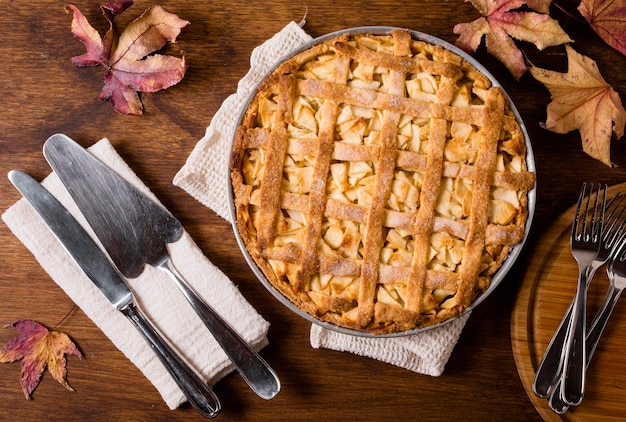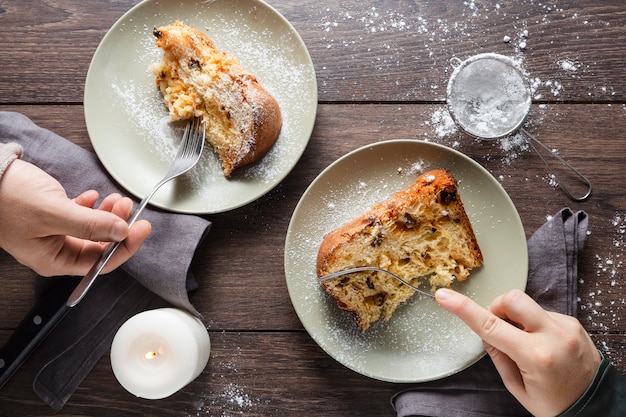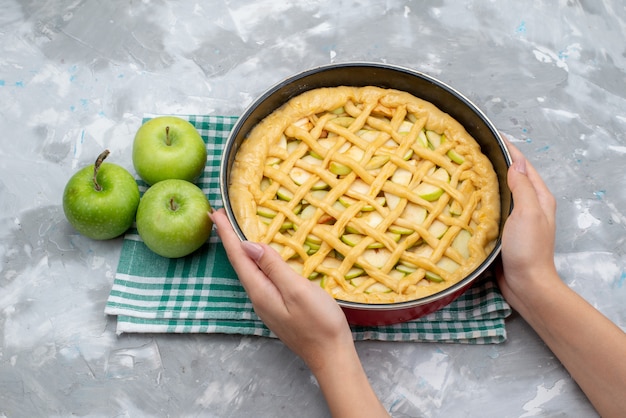The aroma of freshly baked apple pie, with its warm, golden-brown crust and the promise of sweet, spiced apples within, is a sensory delight. It’s a quintessential comfort food that evokes feelings of warmth, nostalgia, and pure happiness. But achieving that perfect pie, with a flaky crust and a perfectly cooked filling, requires understanding the nuances of baking time.
I'm not a pastry chef, but I'm a passionate home baker who's spent countless hours in the kitchen, learning the tricks of the trade. I've had my share of baking mishaps, from soggy bottoms to burnt crusts, but through trial and error, I've discovered the secrets to a truly delicious apple pie. Today, I'm sharing my knowledge and experience, along with some tips and tricks, to help you bake a masterpiece.
Part 1: Unpacking the Apple Pie

The Components of a Classic
Before we dive into the baking process, let's understand the elements that make up an apple pie. It's not simply a random assortment of ingredients; it's a harmonious blend of textures and flavors, working together to create a culinary delight.
- The Crust: The foundation of your pie, the sturdy, golden-brown shell that holds everything in place. You can create a homemade crust from scratch using flour, butter, and water, or opt for a pre-made crust from your local supermarket. Either way, a good crust should be flaky, tender, and slightly sweet.
- The Filling: The heart and soul of the pie, brimming with sliced apples, sugar, spices, and sometimes a touch of butter or cornstarch for thickening. The filling should be sweet, tart, and infused with the warm aroma of cinnamon and other spices.
- The Top Crust: The elegant finishing touch, a protective layer that adds visual appeal to your pie. It can be a lattice top, a single crust, or even a simple crumble. The top crust should be golden brown and crisp, providing a delightful contrast to the soft, tender filling.
Ingredient Matters
Each ingredient plays a crucial role in the final outcome of your pie. Understanding the nuances of these components will help you achieve a better understanding of baking time.
- Crust: A thicker crust will require a longer baking time than a thinner one. The type of flour also impacts baking time, with different flours having varying gluten levels and moisture content.
- Filling: The amount of liquid in the filling directly affects baking time. A filling with more liquid will need longer to bake as the liquid needs to evaporate. The type of apples you choose is also important, as some varieties, like Granny Smith, are naturally more tart and may require longer baking times than sweeter apples.
- Top Crust: A lattice top or single crust needs a longer baking time than a crumble due to their thicker nature and need to bake through properly.
Part 2: Setting the Stage for Success

Once you've gathered your ingredients and chosen your recipe, you're ready to begin baking. But before you pop that pie into the oven, there are a few essential steps to ensure a successful bake.
Chilling the Crust: A Vital Step
The first step is to chill the dough for at least 30 minutes, preferably an hour. This chilling step is crucial for preventing shrinkage during baking and ensuring a beautifully shaped pie with a flaky, delicious crust. Think of it as giving the dough time to relax and firm up, making it easier to work with.
Assembling the Pie
Next, you'll assemble your pie. This involves carefully placing the crust in your pie dish, filling it with the prepared apple mixture, and covering it with the top crust. Take your time with this step, ensuring the crust is evenly distributed and the filling is neatly packed. A well-assembled pie is the first step to a successful bake.
Preheat Your Oven: A Critical Step
Preheating your oven to the correct temperature is non-negotiable for an evenly cooked pie. A preheated oven ensures that your pie bakes evenly, preventing a raw center or a burnt crust. Preheat your oven to 400°F (200°C). This high temperature helps create a crispy crust and cooks the apples quickly.
Part 3: The Baking Process: Patience and Observation

With your pie assembled and your oven preheated, it's time to bake! This is the moment of truth, where all your hard work culminates in a delicious apple pie.
The Initial Bake: Setting the Foundation
Once your oven reaches temperature, place your pie in the oven and bake it for the first 15 minutes. This initial baking time is vital for setting the crust and preventing it from becoming soggy. You may see steam escaping from the vents in the crust – this is normal and a sign that the pie is cooking properly.
Reducing the Temperature: Slow and Steady
After the initial 15 minutes, reduce the oven temperature to 350°F (175°C). This lower temperature allows the filling to bake through without burning the crust. The lower heat ensures that the filling cooks evenly and doesn't become mushy or overcooked.
Checking for Doneness: A Sign of Success
The moment of truth: Checking for doneness is essential to avoid overbaking. The best way to check is to insert a toothpick into the centre of the pie. If it comes out clean, your pie is done. If there are still some apple bits clinging to the toothpick, bake for a few more minutes and check again.
The baking time for an apple pie can vary depending on several factors:
- Type of crust: A homemade crust, with its greater thickness, will take a bit longer to bake than a store-bought crust.
- Type of apples: Some apple varieties cook faster than others. Granny Smith apples, for example, tend to need a bit longer baking time due to their tartness.
- Oven temperature: An oven that's too hot can lead to a burnt crust before the filling is cooked through. Conversely, an oven that's too cool will extend baking time, potentially making the crust soggy.
- Size of the pie: A smaller pie will take less time to bake than a larger pie.
As a general rule, an apple pie should bake for approximately 45 minutes to an hour. However, always check for doneness with a toothpick, as ovens and ingredients can vary.
Part 4: The Final Touches: Patience Pays Off
Once your pie is cooked, it's crucial to allow it to cool slightly before slicing and serving. This cooling time allows the filling to thicken and the crust to firm up.
Cooling and Serving: A Moment of Anticipation
Let your apple pie cool on a wire rack for at least 30 minutes before cutting into it. This allows the filling to set properly and prevents the pie from becoming soggy. Once cooled slightly, you can serve it warm with a scoop of vanilla ice cream or a dollop of whipped cream. The contrasting flavors and textures create a truly indulgent experience.
Storing Leftovers: Preserving the Goodness
If you have leftover apple pie, store it at room temperature for up to 2 days or in the refrigerator for up to 3 days. To reheat, place a slice of pie in the microwave for a few seconds or in a preheated oven at 350°F (175°C) for about 10 minutes. While the flavors may be slightly diminished, reheated apple pie still offers a comforting and satisfying treat.
Part 5: Achieving Pie Perfection: Secrets to Success
Now that you've mastered the fundamentals, let's delve into some insider tips and tricks to elevate your apple pie to a new level of deliciousness.
Apple Selection: The Foundation of Flavor
The secret to a truly exceptional apple pie lies in choosing the right apples. Here are some of the best varieties for pie baking:
- Granny Smith: This tart apple holds its shape well during baking, providing a refreshing balance to the sweetness of the pie. Its vibrant green color also adds a touch of visual appeal.
- Honeycrisp: This sweet and crisp apple bursts with flavor, adding a delightful dimension to your pie. Its juicy texture is a welcome contrast to the flaky crust.
- Braeburn: A balanced combination of tartness and sweetness, this apple holds its shape well during baking and offers a rich, complex flavor.
- Gala: A sweet and juicy apple, Gala adds a touch of sweetness to your pie, making it a popular choice for those who prefer a less tart pie.
For a truly unique flavor, try using a blend of different apple varieties. Experiment with combinations of sweet and tart apples for a symphony of flavors.
Spice It Up: Adding Depth and Warmth
Spices play a crucial role in enhancing the flavor of your apple pie. While cinnamon is a classic, explore the possibilities of other spices, such as nutmeg, allspice, ginger, or cloves, for a more complex and aromatic pie.
The Power of Butter: Richness and Flavor
A touch of butter in your pie filling adds richness and a lovely buttery flavor. Use high-quality butter for the best results. The butter melts during baking, creating a luscious sauce that coats the apples.
Thickening the Filling: Preventing Runniness
Adding a tablespoon or two of cornstarch to your filling helps to thicken it and prevent it from becoming runny. This ensures that your pie has a beautiful, custardy filling that won't spill out when you cut into it.
Mastering the Lattice Top: A Touch of Elegance
A lattice top is a classic and beautiful way to finish off your apple pie. If you're feeling adventurous, try making a lattice top. It's not as difficult as it seems. The woven pattern creates a delicate and visually appealing finish that adds an extra touch of charm to your pie. Remember, practice makes perfect!
Part 6: blind baking: A Decision to Make
One of the big questions that arises when baking apple pie is whether to blind bake the crust. Blind baking refers to pre-baking the crust before adding the filling. This technique helps prevent a soggy bottom crust but adds extra time to your baking process.
So, what's the best approach? It's a matter of personal preference.
Pros and Cons of Blind Baking
| Blind Baking | Not Blind Baking |
|---|---|
| Pros: Prevents soggy bottom crust | Pros: Faster baking time |
| Cons: Adds extra baking time | Cons: Can result in a soggy bottom crust |
Tips for Blind Baking: Ensuring Success
If you decide to blind bake your crust, here are a few tips to ensure a beautifully crisp base:
- Prick the bottom of the crust: This allows steam to escape, preventing the crust from puffing up unevenly.
- Use pie weights: Pie weights help to prevent the crust from sagging during baking. You can use dried beans, rice, or even pie weights designed for this purpose.
- Bake for 10-15 minutes: Blind bake the crust for about 10-15 minutes before adding the filling.
Part 7: Beyond the Basics: Creating Your Signature Pie
So far, we've covered the fundamentals of apple pie baking time and techniques. But let's get creative! If you're looking to elevate your apple pie game, there are endless possibilities for flavor combinations and variations.
Apple Pie with a Twist: Adding Personal Flair
Want to try something a bit different? Here are a few ideas to spark your creativity:
- Add a splash of liqueur: A touch of brandy, apple cider, or even a hint of rum can add a delicious depth of flavor to your pie. The alcohol evaporates during baking, leaving behind a subtle aroma and enhanced flavor.
- Incorporate nuts: Toasted pecans, walnuts, or almonds add a delightful crunch and nutty flavor to your apple pie. The nuts provide a textural contrast and a rich, savory element to the sweetness of the apples.
- Experiment with spices: Get creative with spices! Try cardamom, ginger, cloves, or even a touch of star anise for a unique twist. Each spice brings its own distinct aroma and flavor profile, adding depth and complexity to your pie.
- Add a touch of citrus: A squeeze of lemon juice or a dash of orange zest can brighten up the flavor of your apple pie. Citrus adds a refreshing acidity that balances the sweetness of the apples and spices.
- Try a different crust: Instead of a traditional pie crust, try using a crumble topping, a puff pastry crust, or even a graham cracker crust. These variations offer unique textures and flavors that can change the character of your pie.
Part 8: The Apple Pie Chronicles: Lessons Learned
Over the years, I've had my fair share of memorable experiences with apple pie. There have been times when I thought I'd ruined everything, like that time I forgot to preheat the oven and ended up with a raw pie filling. But there have also been moments of pure triumph, like that time I baked a pie for a community bake sale and it was the first one to sell out. It felt like a culinary victory!
These experiences, both good and bad, have shaped my journey as a pie baker. They've taught me the importance of patience, practice, and experimentation. And above all, they've reminded me that baking is a labor of love, a process that requires both skill and passion.
FAQs: Addressing Common Questions
1. What if my apple pie is still soft after baking for the recommended time?
If your apple pie is still soft after baking, it might need a little more time. Increase the baking time by 5-10 minutes and check again for doneness. You can also try covering the pie with a piece of aluminum foil during the last 15 minutes of baking to prevent the crust from over-browning while the filling continues to cook.
2. What happens if I overbake my apple pie?
Overbaking your apple pie can lead to a dry and burnt crust. It's best to check for doneness early and avoid overbaking. If you notice the crust is getting too brown, cover it with a piece of aluminum foil to prevent further browning.
3. Can I freeze apple pie?
Yes, you can freeze apple pie! To freeze, let the pie cool completely. Wrap it tightly in plastic wrap and then in aluminum foil. You can freeze the pie for up to 3 months. To thaw, place the frozen pie in the refrigerator overnight. Reheat the thawed pie in a preheated oven at 350°F (175°C) for about 30 minutes.
4. How do I prevent a soggy bottom crust?
The best way to prevent a soggy bottom crust is to blind bake it before adding the filling. Blind baking allows the crust to cook through and become more rigid, preventing it from becoming soggy. If you don't blind bake, make sure your filling is not overly liquid. You can thicken the filling with cornstarch or drain excess liquid from the apples before adding them to the crust.
5. What are some tips for making a flaky pie crust?
A flaky pie crust is the key to a delicious apple pie. Here are a few tips to help you achieve that perfect flaky crust:
- Use cold ingredients: Cold butter and water help to create a flaky texture. The cold fat prevents it from melting too quickly, creating pockets of air that result in a flaky crust.
- Don't overwork the dough: Overworking the dough will make it tough. Handle the dough gently, using a light touch to incorporate the ingredients.
- Chill the dough: Chilling the dough for at least 30 minutes will help to prevent shrinkage during baking. Allowing the dough to rest in the refrigerator allows the gluten to relax, resulting in a more tender crust.
- Use a pastry blender or fork: These tools will help to incorporate the butter into the flour without overworking the dough. The goal is to create small pieces of butter that will melt during baking, resulting in a flaky crust.
Everyone is watching

Corn on the Cob: The Ultimate Guide to Perfectly Cooked Ears
Healthy MealsAh, corn on the cob. Just the name evokes images of sunny days, barbecues, and that sweet, juicy flavour that ...

Scallops: The Ultimate Guide to Perfect Cooking
Healthy MealsAh, scallops. Those delicate, sweet, and utterly delicious morsels of the sea. They hold a special place in my...

Spaghetti Squash: The Ultimate Guide to Cooking and Serving
Healthy MealsRemember that time you saw spaghetti squash at the supermarket, looking all bumpy and strange, and thought, "W...

Salmon Cooking Times: Perfect Guide for Every Recipe
Healthy MealsLet me tell you, cooking salmon is an art form. It's all about getting that perfect balance: juicy and tender,...

Ham Cooking Time: How Long to Bake, Smoke, or Boil a Delicious Ham
Healthy MealsAh, ham. It's a classic, isn't it? A real crowd-pleaser, especially around holidays. And when done right, it'...
